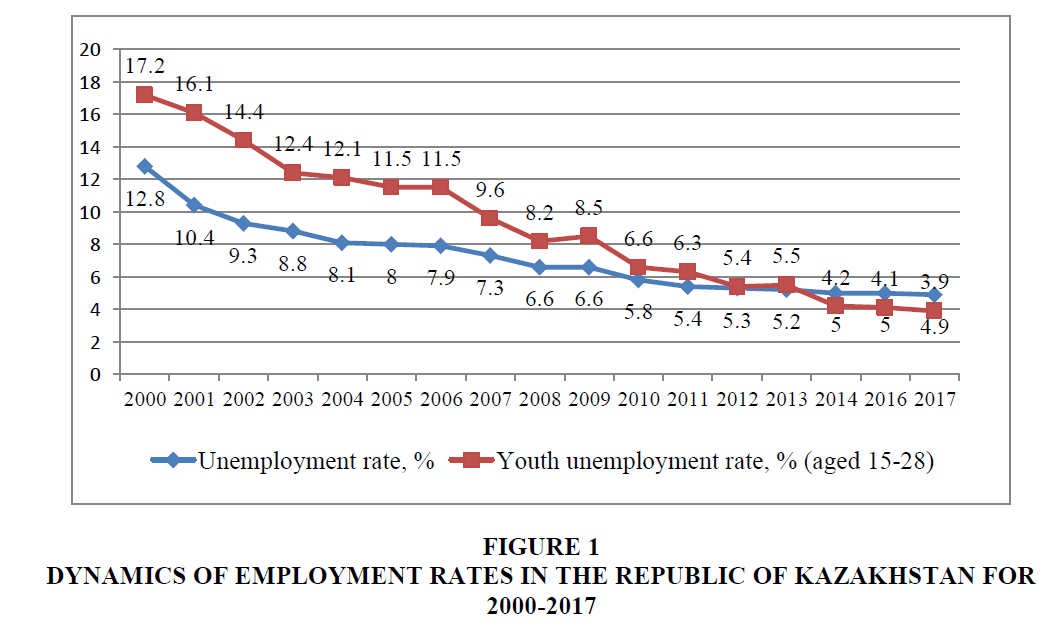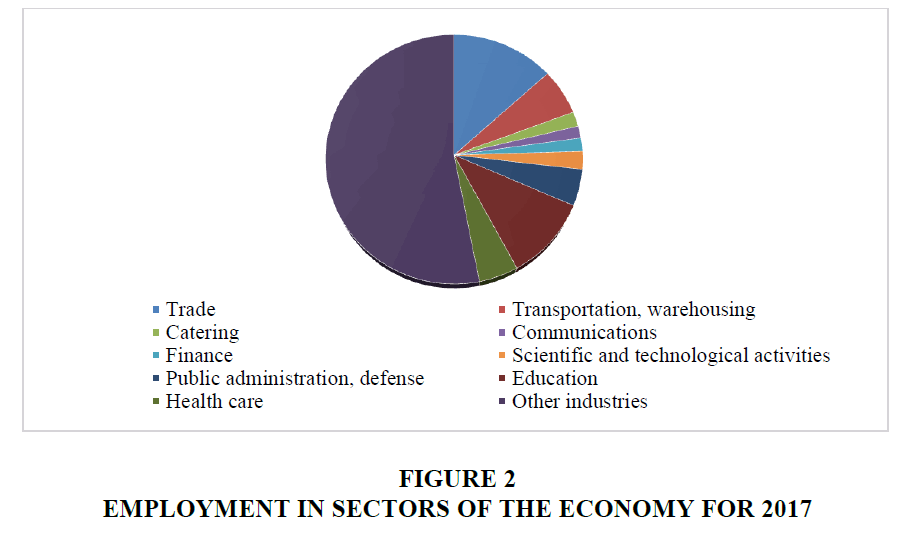Research Article: 2019 Vol: 18 Issue: 6
Assessment of the Current State of Employment in the Regions of Kazakhstan
Gulashar Zh. Doskeyeva, Narxoz University
Kulsara A. Baitalassova, Narxoz University
Dilyara N. Omarkhan, Kazakh-American Free University
Raushan Zh. Bekova, Turan University
Assel E. Rakhimbekova, Kazakh University of Economics
Abstract
This article discusses the current state of employment in the Republic of Kazakhstan in the context of individual regions and sectors of the economy. It analyzes the dynamics of changes in employment, unemployment and youth unemployment, as well as identifies employment issues in certain sectors of the economy. In order to address these issues, the authors propose improving measures taken by the state in the field of rural employment policy, in particular, provision of the rural population with jobs, training and retraining of rural youth, support and development of rural entrepreneurship.
Keywords
Social Modernization, Money Income Index, Unemployment, Youth Unemployment, Employment, Employment in Sectors of the Economy.
Introduction
According to the state policy of social modernization in the Republic of Kazakhstan, four main areas can be distinguished in the field of employment:
• Provision of sustainable and productive employment through the development of labor potential, assistance in employment at the place of residence;
• Promotion of rural entrepreneurship development;
• Increase in the mobility of labor resources by facilitating the voluntary relocation of citizens of the Republic of Kazakhstan from communities with low socio-economic development potential to communities with a high potential and to economic growth centers;
•Provision of employment through the implementation of infrastructure projects in rural areas with medium or high socio-economic development potential.
In the context of social modernization, social efficiency is acquiring particular relevance, which is the main criterion for assessing the level of social infrastructure development, productivity and labor motivation.
For the purpose of implementing the policy of social modernization in the field of employment in Kazakhstan, state and regional programs are being carried out to address the problems of unemployment, such as the state program “Employment Road Map-2020”, the state development program for Kazakhstan’s regions “Regions-2020” and other regional programs, aimed at solving the problems of social modernization of the economy of the regions and the country as a whole.
One of the indicators characterizing the effectiveness of the state social policy is the unemployment rate, which is calculated by dividing the number of unemployed persons by the total labor force. This article will consider the dynamics of changes in employment indicators in Kazakhstan and its individual regions and sectors of the economy, as well as identify the unemployment rate.
Materials And Methods
In order to provide complex and throughout assessment of the current state of employment in the regions of Kazakhstan the authors have used the followed methods:
• Unemployment rate detecting and analyzing compared with previous years in order to detect tendencies of increasing or decreasing;
• Relevant literature review to study the theoretical and practical basis of the problem in Kazakhstan and other countries;
• Analyzing multiple state and regional programs that are being carried out to meet the problems of unemployment;
• Statistical method;
• Generalizing in order to find decisions and recommendations for decreasing the level of unemployment in the context of policy of modernization of Kazakhstan’s economy.
Literature Review
The problems of unemployment are relevant not only for individual states; they are being considered at the international level and studied by scientists all over the world. For example, examining the problems of unemployment in European countries, Ghoshray et al. (2016) argue that the occurrence of structural breaks in European unemployment is associated with major institutional events. They believe that adult unemployment is more susceptible to structural breaks, while youth unemployment is more sensitive to business cycle fluctuations, especially in times of crisis.
The works of Caliendo & Schmidl (2016) and Fosten & Ghoshray (2011) are also devoted to the analysis of the labor market and unemployment problems in European countries and in OECD countries.
According to Calvo et al. (2012), either higher unemployment (“jobless recovery”) or a lower real wage (“wageless recovery”) determines recovery from financial crises. The type of recovery depends on inflation: low inflation is “associated with jobless recovery”, while high inflation is “associated with wageless recovery”. Jobless recovery can lead to an increase in both long-term and structural unemployment.
Boeri et al. (2013) indicate that the volatility of the labor market is primarily affected by financial crises. The work of Tridico (2013) is also devoted to the impact of the global economic crisis on unemployment in individual countries. He believes that the countries, which adhered to a flexibility model, such as Ireland, Spain and the United Kingdom, faced deterioration in the situation on the labor market (Bernal-Verdugo et al., 2012). Some of the western EU countries, like France, Italy, Portugal, Spain and Sweden, faced a large increase in unemployment, while Greece and Ireland experienced multiple failures.
A number of research works are devoted to youth unemployment, which is a relevant issue for all countries regardless of their level of socio-economic development. Among them are the works by Dietrich (2012); Goudswaard & Andries (2001). Particularly, Gontkovi?ová et al. (2015) from the University of Economics in Bratislava examine the relationship between youth unemployment and education. According to them, the highest unemployment rate is observed among those young people who do not have a special education.
According to Antosova (2010), investments in the education of young people provide a steady income throughout their lives. However, Abel et al. (2014) emphasize that as a result of the Great Recession and the slow recovery, many college graduates cannot find jobs in their specialty. According to Chi?iba (2012), the problem of lifelong learning should also be an urgent task for researchers of unemployment. Strandh et al. (2014) consider the relationship between youth unemployment and mental abilities.
Results And Discussion
The active implementation of Kazakhstan’s policy of social modernization has brought positive results in the field of employment. According to official statistics, in the period from 2000 to 2017 in Kazakhstan, the unemployment rate fell from 12.8% to 4.9%, i.e. 2.6 times. During the analyzed period, there was a decrease in the youth unemployment rate from 17.2% to 3.9%, i.e. it decreased by 4.4 times for 2000-2017 (Figure 1).
The state policy carried out in the field of employment has showed its positive results in terms of providing jobs for the able-bodied population aged 15-28. According to the Statistics Committee of the Ministry of National Economy of the Republic of Kazakhstan, in all regions of Kazakhstan there was a decrease in youth unemployment from 2000-2017. A significant reduction in youth unemployment was observed in the Atyrau region: in 2017, compared with 2000, youth unemployment decreased by 9.6 times. For the analyzed 17 years, a significant reduction in youth unemployment was observed in Almaty (4.9 times), Akmola (5.6 times), Aktobe (5.9 times), North Kazakhstan (6 times), Kostanay (5.2 times) regions.
As for the employment structure by branches of the economy, according to official statistics, in 2017 64.8% of the total employed population of the republic engaged in the service sector, 19.8% - in industry and construction, 15.4% - in agriculture, forestry and fisheries. While the number of people employed in the service sector and industry increased over the analyzed period, it can be seen from statistical data that the share of people employed in agriculture, forestry and fisheries decreased from year to year. If in 2000 31.3% of the total employed number of people engaged in agriculture, forestry and fisheries, in 2017 this figure was 15.4%. Such a reduction (2 times) in the number of people employed in agriculture, forestry and fisheries can be explained by the intensification of the urbanization process in the regions, the involvement of the able-bodied rural population in other sectors of the economy and the increase in the number of jobs in non-agricultural sectors of the economy as a result of the implementation of state and regional employment programs.
As for other sectors of the economy, the share of employed in sectors of the economy in the total employed population is as follows: in trade-15.5%, education-12.3%, transportation and warehousing-7%, health care-5.6%, public administration and defense-5.5%. According to the statistics of 2017, the provision of the population with jobs in sectors of the economy and the share of the population employed in these sectors can be seen in Figure 2.
In general, the statistics show that for 2013-2017 in many sectors of the country's economy there was an increase in the process of providing the population with jobs. If over the analyzed period, the number of people employed in industry and construction increased by 3.9%, in the service sector this figure increased by 15.9%.
However, there are problems demanding immediate solution. One of them is the sharp decline in the population employed in agriculture, forestry and fisheries. In 2013-2017, the number of people employed in these sectors decreased by 57.2%. Taking into account the fact that about 40% of Kazakhstan’s population live in rural areas, and mainly rural people are employed in the above-mentioned sectors, one should understand that the reduction of jobs in these sectors indicates an increase in unemployment among the rural population. In this regard, it is necessary to improve the mechanism of state support for the rural population to ensure their employment by training and retraining rural youth for new specialties, supporting rural entrepreneurship, developing the activities of agricultural enterprises and creating new jobs, etc.
Conclusions
In conclusion, it should be noted that there is a need to implement the following actions and measures in order to enhance the process of providing employment in Kazakhstan’s regions:
• Training and retraining of structurally unemployed and rural youth for other specialties;
• Improvement of information support;
• Improvement of the activities of employment centers;
• Targeted state support of enterprises and organizations in order to preserve jobs;
• Enhancement of the efficiency of registering the unemployed, provision of jobs and social assistance for them;
• Strengthening of measures to ensure the employment of women, youth, the disabled and other representatives of socially vulnerable groups.
References
- Abel, J.R., Deitz, R., & Su, Y. (2014). Are recent college graduates finding good jobs?.Current Issues in Economics and Finance,20(1), 12-16.
- Antosova, M. (2010). Human resources management and organizational development as a basis for the knowledge management. Acta Montanistica Slovaca, 15, 90-95.
- Bernal-Verdugo, L.E., Furceri, D., & Guillaume, D. (2012). Labor market flexibility and unemployment: new empirical evidence of static and dynamic effects.Comparative Economic Studies,54(2), 251-273.
- Boeri, T., Garibaldi, P., & Moen, E.R. (2013). Financial shocks and labor: facts and theories.IMF Economic Review,61(4), 631-663.
- Caliendo, M., & Schmidl, R. (2016). Youth unemployment and active labor market policies in Europe.IZA Journal of Labor Policy,5(1), 1.
- Calvo, G.A., Coricelli, F., & Ottonello, P. (2012). The labor market consequences of financial crises with or without inflation: Jobless and wageless recoveries.
- Chitiba, C.A. (2012). Lifelong learning challenges and opportunities for traditional universities.Procedia-Social and Behavioral Sciences,46, 1943-1947.
- Dietrich, H. (2012). Youth Unemployment in Europe. Theoretical Considerations and Empirical Findings, Friedrich Ebert Stiftung, Berlin.
- Fosten, J., & Ghoshray, A. (2011). Dynamic persistence in the unemployment rate of OECD countries.Economic Modelling,28(3), 948-954.
- Ghoshray, A., Ordóñez, J., & Sala, H. (2016). Euro, crisis and unemployment: Youth patterns, youth policies?.Economic Modelling,58, 442-453.
- Gontkovicová, B., Mihalcová, B., & Pru?inský, M. (2015). Youth unemployment?current trend in the labour market?.Procedia Economics and Finance,23, 1680-1685.
- Goudswaard, A., & Andries, F. (2002).Employment status and working conditions. European Foundation for the Improvement of Living and Working Conditions.
- Strandh, M., Winefield, A., Nilsson, K., & Hammarström, A. (2014). Unemployment and mental health scarring during the life course.The European Journal of Public Health,24(3), 440-445.
- Tridico, P. (2013). The impact of the economic crisis on EU labour markets: A comparative perspective.International Labour Review,152(2), 175-190.

